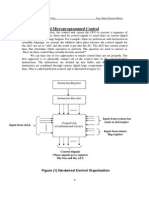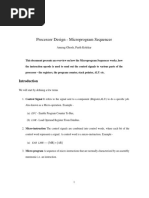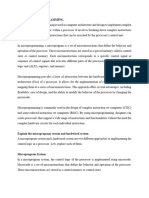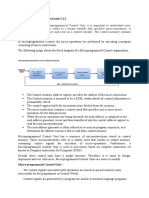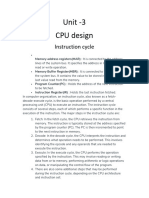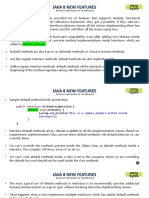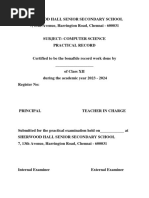Chapter Eight Microprogrammed Control: Computer Architecture
Chapter Eight Microprogrammed Control: Computer Architecture
Uploaded by
2022-112836Copyright:
Available Formats
Chapter Eight Microprogrammed Control: Computer Architecture
Chapter Eight Microprogrammed Control: Computer Architecture
Uploaded by
2022-112836Original Title
Copyright
Available Formats
Share this document
Did you find this document useful?
Is this content inappropriate?
Copyright:
Available Formats
Chapter Eight Microprogrammed Control: Computer Architecture
Chapter Eight Microprogrammed Control: Computer Architecture
Uploaded by
2022-112836Copyright:
Available Formats
Computer Architecture
Chapter Eight Programming the Basic Computer
CHAPTER EIGHT
MICROPROGRAMMED CONTROL
8.1. Introduction
In any digital computer, the function of the control unit is to initiate
sequences of microoperations. The number of different types of
microoperations that are available in a given system is finite.
Generally, control unit of a digital computer may be designed using one
of the following techniques:
1. Hardwired Control Unit
In this type, the control signals are generated by hardware using
conventional logic design techniques.
2. Microprogrammed Control Unit
In this type, the control variables stored in memory at any given time
can be represented by a string of 1's and 0's called a control word.
As such, control words can be programmed to perform various
operations on the components of the system.
Each word in control memory contains within it a microinstruction.
Generally, a microinstruction specifies one or more microoperations.
A sequence of microinstructions forms what is called a
microprogram.
Generally, a computer that employs a microprogrammed control unit will
have two separate memories:
1. The main memory
This memory is available to the user for storing programs. The user's
program in main memory consists of machine instructions and data.
2. The control memory
This memory contains a fixed microprogram that cannot alter by the
occasional user. The microprogram consists of microinstructions that
specify various internal control signals for execution of register
microoperations.
Page 1 of Chapter 8 Yacoup K. Hanna
Computer Architecture
Chapter Eight Programming the Basic Computer
Each instruction initiates a series of microinstructions in control
memory. These microinstructions generate the microoperations
to:
1. Fetch the instruction from main memory.
2. Evaluate the effective address.
3. Execute the operation specified by the instruction.
4. Finally, return the control to the fetch phase in order to repeat
the cycle for the next instruction.
Figure 8.1 shows the general block diagram of a microprogrammed
control unit which assumed to be a ROM.
External Control
input Next Control Control Control word
address address memory data
generator Register (ROM) Register
Next-address information
Figure 8.1
The function of the control address register is to specify the address
of the microinstruction, while the function of control data register is to
holds the microinstruction read from memory.
The microinstruction contains a control word that specifies one or
more microoperations for the data processor. Once these
operations are executed, the control must determine the next address.
The location of the next microinstruction may be the one next in
sequence, or it may be located somewhere else in the control memory.
For this reason it is necessary to use some bits of the present
microinstruction to control the generation of the address of the next
microinstruction. The next address may also be a function of external
input conditions. While the microoperations are being executed, the
next address is computed in the next address generator circuit and then
transferred into the control address register to read the next
microinstruction.
Thus a microinstruction contains bits for initiating microoperations in the
data processor part and bits that determine the address sequence for
the control memory.
Page 2 of Chapter 8 Yacoup K. Hanna
Computer Architecture
Chapter Eight Programming the Basic Computer
The next address generator is sometimes called a microprogram
sequencer, as it determines the address sequence that is read from
control memory.
Depending on the sequencer inputs, the address of the next
microinstruction can be specified in several ways:
1. By incrementing control address register by one.
2. Loading the control address register an address from control
memory.
3. Transferring an external address.
4. Loading an initial address to start the control operations.
The control data register holds the present microinstruction while the
next address is computed and read from memory. The data register is
sometimes called a pipeline register. It allows the execution of the
microoperations specified by the control word simultaneously with the
generation of the next microinstruction. This configuration requires a
two-phase clock, one clock applied to the address register and the
other to the data register.
The system can operate without the control data register by applying a
single-phase clock to the address register. The control word and next-
address information are taken directly from the control memory.
It must be realized that a ROM operates as a combinational circuit, with
the address value as the input and the corresponding word as the
output. The content of the specified word in ROM remains in the output
wires as long as its address value remains in the address register. No
read signal is needed as in a random-access memory. Each clock pulse
will execute the microoperations specified by the control word also
transfer a new address to the control address register.
In the example that follows we assume a single-phase clock and
therefore we do not use a control data register, in this way the address
register is the only component in the control system that receives clock
pulses. The other two components: the sequencer and the control
memory are combinational circuits and do not need a clock.
The main advantage of the microprogrammed control is the fact
that once the hardware configuration is established; there should
be no need for further hardware or wiring changes. If we want to
establish a different control sequence for the system, all we need to do
is specify a different set of microinstructions for control memory
(i.e. different microprogram residing in control memory).
Page 3 of Chapter 8 Yacoup K. Hanna
Computer Architecture
Chapter Eight Programming the Basic Computer
8.2. Address Sequencing
Each computer has a set of instructions; each instruction has its own
microprogram routine in control memory which generates the
microoperations that execute it.
When the computer is turned on, an initial address is loaded into the
control address register. This address usually presents the first address
of the microinstruction that activates the instruction fetch routine. The
fetch routine may be sequenced by incrementing the control address
register through the rest of its microinstructions. At the end of the fetch
routine, the instruction is loaded in the instruction register.
The next step is to determine the effective address of the operand. The
effective address computation routine in control memory can be
reached through a branch microinstruction, which is conditioned on the
status of the mode bits of the instruction. When the effective address
computation routine is completed, the address of the operand is
available in the memory address register.
The following step is to generate the microoperations that execute the
instruction fetched from memory. Each instruction has its own
microprogram routine stored in a given location of control memory.
The process that transforms the instruction code bits to an address in
control memory where the routine is located is referred as a mapping
process. Once the required routine is reached, the microinstructions that
execute the instruction may be sequenced by incrementing the control
address register, but sometimes the sequence of microoperations will
depend on values of certain status bits in processor registers.
Microprograms that employ subroutines will require an external
register to store the return address, since the return addresses cannot
be stored in ROM.
When the execution of the instruction is completed, control must return
to the fetch routine. This is accomplished by executing an unconditional
branch microinstruction to the first address of the fetch routine.
Page 4 of Chapter 8 Yacoup K. Hanna
Computer Architecture
Chapter Eight Programming the Basic Computer
In summary, the address sequencing capabilities required in a control
memory are:
1. Incrimination of the control address register.
2. Unconditional branch or conditional branch, depending on
status bit conditions.
3. A mapping process from the bits of the instruction to an
address for control memory.
4. A facility for subroutine call and return.
Figure 8.2 shows a block diagram of a control memory and the
associated hardware needed for selecting the next microinstruction
address.
Each microinstruction in control memory contains:
1. A set of bits to initiate microoperations in computer registers.
2. A set of bits to specify the method by which the next microin-
struction address is obtained.
Figure 8.2
Page 5 of Chapter 8 Yacoup K. Hanna
Computer Architecture
Chapter Eight Programming the Basic Computer
The diagram shows four different paths from which the control
address register (CAR) receives the address of the next
instruction.
1. By incrementer, which increments the content of the control
address register by one.
2. By branching; this is achieved by specifying the branch address in
one of the fields of the microinstruction. Conditional branching is
obtained by using part of the microinstruction to select a specific
status bit in order to determine its condition.
3. An external address via a mapping logic circuit is transferred into
control memory.
4. The return address for a subroutine is stored in a special register
whose value is then used when the microprogram wishes to
return from the subroutine.
Conditional Branching
The branch logic of Fig. 8.2 provides decision-making capabilities in
the control unit.
In every digital system, the status conditions are special bits that
provide parameter information such as:
1. The carry-out of an adder.
2. The sign bit of a number.
3. The mode bits of an instruction.
4. Input or output status conditions.
The field which specifies a branch address in the microinstruction,
together with the status bits, controls the conditional branch decisions
generated in the branch logic.
The simplest way to implement the branch logic hardware is to test the
specified condition and branch to the indicated address if the
condition is met; otherwise, the address register is incremented.
This can be implemented using a multiplexer. For example, suppose that
there are eight status bit conditions in the system. Therefore, three bits in
the microinstruction are used to specify one of the eight status bit
conditions. These three bits provide the selection variables for the
multiplexer. If the selected status bit is in the 1 state, the output of the
Page 6 of Chapter 8 Yacoup K. Hanna
Computer Architecture
Chapter Eight Programming the Basic Computer
multiplexer is 1; otherwise, it is 0. A 1 output in the multiplexer
generates a control signal to transfer the branch address from the
microinstruction into the control address register. A 0 output in the
multiplexer causes the address register to be incremented. In this
configuration, the microprogram follows one of two possible paths,
depending on the value of the selected status bit.
An unconditional branch microinstruction can be implemented by
loading the branch address from control memory into the control
address register via the multiplexer. This can be accomplished by
fixing the value of one status bit at the input of the multiplexer, so it is
always equal to 1. A reference to this bit by the status bit select lines
from control memory causes the branch address to be loaded into the
control address register unconditionally.
Mapping of Instruction
A special type of branch exists when a microinstruction specifies a
branch to the first word in control memory where a microprogram
routine for an instruction is located. The status bits for this type of branch
are the bits in the operation code part of the instruction.
For example, suppose a computer with an instruction format as shown
in Fig. 8.3. four bits are specified for the operation code which specifies
up to 16 distinct instructions. Assume further that the control memory
has 128 words, requiring an address of seven bits. As mentioned
before, the control memory includes a microprogram routine for each
operation code that executes the corresponding instruction.
Figure 8.3
Page 7 of Chapter 8 Yacoup K. Hanna
Computer Architecture
Chapter Eight Programming the Basic Computer
One simple mapping process that converts the 4-bit operation code to
a 7-bit address for control memory is shown in Fig. 8.3. This mapping
consists of placing a 0 in the most significant bit of the address,
transferring the four-operation code bits, and cleaning the two least
significant bits of the control address register.
This provides for each computer instruction a microprogram routine
with a capacity of four microinstructions, if the routine needs more than
four microinstructions, it can use addresses 1000000 through 1111111.
If it uses fewer than four microinstructions, the unused memory
locations would be available for other routines.
A more general mapping rule can be achieved by using a ROM to
specify the mapping function. In this configuration, the bits of the
instruction specify the address of a mapping ROM. The contents of the
mapping ROM give the bits for the control address register.
The advantages of this mapping process are:
1. The microprogram routine that executes the instruction can be
placed in any desired location in control memory.
2. It provides flexibility for adding new subroutines for new
instructions in the control memory as the need arises.
Subroutines
Subroutines are programs that are used by other routine to
accomplish a particular task.
An example of these subroutines is the subroutine needed to
generate the effective address of the operand for an instruction. This
is common to all memory reference instructions.
A subroutine can be called from any point within the main body of
the microprogram.
Page 8 of Chapter 8 Yacoup K. Hanna
Computer Architecture
Chapter Eight Programming the Basic Computer
8.3. Microprogram Example
When the configuration and the microprogrammed control unit of the
computer are established, the designer's task is to generate the
microcode for the control memory. This code generation is called
microprogramming.
Computer Configuration
To explain the microprogramming process, we present a simple
digital computer similar but not identical to the basic computer
introduced in chapter 6.
Figure 8.4 shows the block diagram of this computer.
Figure 8.4
Page 9 of Chapter 8 Yacoup K. Hanna
Computer Architecture
Chapter Eight Programming the Basic Computer
This computer consists of:
1. A main memory ( 2048 × 16 ) for storing instructions and data.
2. A control memory (128 × 20 ) for storing the microprogram.
3. Four registers associated with the processor unit; there
function is similar to the corresponding registers in the basic
computer introduced in chapter 6. These registers are :
a. The Accumulator Register (AC).
b. The Program Counter Register (PC).
c. The Address Register (AR).
d. The Data Register (DR).
4. Two registers associated with control unit:
a. The Subroutine Register (SBR).
b. The Control Address Register (CAR).
5. The Arithmetic Logic and Shift Unit.
6. Two multiplexers for transfer of information among the registers
and the registers and main memory.
From the diagram, it's clear that DR can receive information from AC,
PC, or main memory. AR can receive information either from PC or DR.
PC receives information from AR only. The arithmetic, logic, and shift
unit performs microoperations with data from AC and DR and places the
result in AC. The memory receives its address from AR. Data written to
memory comes from DR, while DR receives the data read from
memory.
Instruction Format
Figure 8.5 presents the instruction format for the assumed computer.
The instruction format consists of three fields:
1. The 1-bit field specified for addressing mode symbolized by I.
2. The 4-bit field specified for operation code (Opcode).
3. The 11-bit field specified for the address.
Figure 8.5
Page 10 of Chapter 8 Yacoup K. Hanna
You might also like
- Chapter3 Control UnitDocument23 pagesChapter3 Control UnitMilan MaharjanNo ratings yet
- CH 7Document12 pagesCH 7utkarsh.shrivastava.ug21No ratings yet
- UNIT-III Part ADocument16 pagesUNIT-III Part Abhargavialluri30No ratings yet
- Microprogrammed ControlDocument9 pagesMicroprogrammed Controlvinaydarling063No ratings yet
- COA Unit-2Document103 pagesCOA Unit-2varshiniveeramalla07No ratings yet
- Microprogrammed ControlDocument37 pagesMicroprogrammed ControlPrince RathoreNo ratings yet
- 02_CS 3004Document21 pages02_CS 3004Mukesh kumarNo ratings yet
- Hardwired and Microprogrammed Control2Document4 pagesHardwired and Microprogrammed Control2adddataNo ratings yet
- Coa Unit-2 Full NotesDocument26 pagesCoa Unit-2 Full NotesVaishnavi VsNo ratings yet
- Memory AccessDocument14 pagesMemory AccessanaputaruntejaNo ratings yet
- COA Unit IIDocument54 pagesCOA Unit IInoumanracerNo ratings yet
- UNIT 4 Microprogrammed Control UnitDocument32 pagesUNIT 4 Microprogrammed Control UnitSatyam ParekhNo ratings yet
- Microprogrammed PDFDocument9 pagesMicroprogrammed PDFNANUVALA TIRUPATHINo ratings yet
- Computer Organisation 1Document21 pagesComputer Organisation 1Swar KhedekarNo ratings yet
- Jntuh Coa Unit 2Document25 pagesJntuh Coa Unit 2krishhuniqueNo ratings yet
- Chapter 1Document12 pagesChapter 1adityadhital7No ratings yet
- COA-Unit 4Document75 pagesCOA-Unit 4misha9824131233No ratings yet
- Unit 4 - Microprogrammed ControlDocument27 pagesUnit 4 - Microprogrammed ControlPiyush KoiralaNo ratings yet
- Co Unit-2Document19 pagesCo Unit-2moseslovely10commandsNo ratings yet
- Unit III Part 1 Microprogramming NotesDocument10 pagesUnit III Part 1 Microprogramming NotesKiranmai KonduruNo ratings yet
- DLCA Module 4 - Control Unit Design Aeraxia - inDocument22 pagesDLCA Module 4 - Control Unit Design Aeraxia - insk10000067100% (1)
- Department of Computer Science & Engineering and Information TechnologyDocument8 pagesDepartment of Computer Science & Engineering and Information Technology22- Aakriti guptaNo ratings yet
- Control UnitDocument4 pagesControl Unitdivine iyawaNo ratings yet
- Unit 3 Control Unit: Computer ArchitectureDocument12 pagesUnit 3 Control Unit: Computer ArchitectureANUJ TIWARINo ratings yet
- 2077 Solution Computer Architecture.Document15 pages2077 Solution Computer Architecture.ea.arpanNo ratings yet
- Unit No: III: Micro Programmed ControlDocument7 pagesUnit No: III: Micro Programmed ControlbhargaviNo ratings yet
- COA Chapter 4 QB With SolutionDocument14 pagesCOA Chapter 4 QB With SolutionHemant TankNo ratings yet
- Co2202 L8 BasicDocument17 pagesCo2202 L8 Basicvidsa2002No ratings yet
- Unit 2 - Computer System Organisation - WWW - Rgpvnotes.inDocument8 pagesUnit 2 - Computer System Organisation - WWW - Rgpvnotes.inmukulgrd1No ratings yet
- Unit - Ii Micro Programmed Control: Control MemoryDocument7 pagesUnit - Ii Micro Programmed Control: Control MemoryKarthik KatakamNo ratings yet
- Punit Mittal Monogram Control UnitDocument9 pagesPunit Mittal Monogram Control UnitPrince RathoreNo ratings yet
- Control MemoryDocument11 pagesControl Memory1759 AlinaNo ratings yet
- Coa 4Document11 pagesCoa 4pahujahimankNo ratings yet
- Lecture 9Document7 pagesLecture 9عبد الهادي معين شهيد كاظمNo ratings yet
- CAO3Document21 pagesCAO3shubham17mittalNo ratings yet
- Unit 4 MicroprocessorDocument31 pagesUnit 4 Microprocessorprajwalbikram731No ratings yet
- Ca Unit Iii 2Document9 pagesCa Unit Iii 2Akash GaonkarNo ratings yet
- MicroProgram SequencerDocument10 pagesMicroProgram SequencerashtonNo ratings yet
- UNIT - 4 NotesDocument17 pagesUNIT - 4 NotesAbhinayNo ratings yet
- Cte 241 MicroprocessorsDocument13 pagesCte 241 MicroprocessorsIorlaha SamuelNo ratings yet
- co2Document16 pagesco2spooja.nmkrvNo ratings yet
- Control UnitDocument29 pagesControl Unitkoshika.lambaNo ratings yet
- Cap Unit 6 AnsDocument10 pagesCap Unit 6 AnsApurva JarwalNo ratings yet
- COA Unit-2 Notes (P1)Document7 pagesCOA Unit-2 Notes (P1)Sayan ChakrabortyNo ratings yet
- HenzonzzzzDocument5 pagesHenzonzzzzapi-548516280No ratings yet
- Chapter 3Document30 pagesChapter 3prototypes6341No ratings yet
- Digital Logic and Computer ArchitectureDocument27 pagesDigital Logic and Computer Architecturemayekarsai332No ratings yet
- Unit - Ii Micro Programmed Control: Control MemoryDocument15 pagesUnit - Ii Micro Programmed Control: Control MemoryKarthik KatakamNo ratings yet
- Microprogramming (Assembly Language)Document24 pagesMicroprogramming (Assembly Language)Thompson MichealNo ratings yet
- Chapter 4Document66 pagesChapter 4hb2202099No ratings yet
- Basic Computer Organization - Part 03Document8 pagesBasic Computer Organization - Part 03Kamala Rani RoyNo ratings yet
- COA Lecture 16 17Document20 pagesCOA Lecture 16 17Chhaveesh AgnihotriNo ratings yet
- Micro Programmed Control Unit 2.1.2Document4 pagesMicro Programmed Control Unit 2.1.2Ashwani KumarNo ratings yet
- Control Unit in Computer ArchitectureDocument13 pagesControl Unit in Computer Architectureamutha dNo ratings yet
- Module 2A Design of Control UnitDocument14 pagesModule 2A Design of Control Unitsehelo9749No ratings yet
- Chap. 7 Microprogrammed ControlDocument14 pagesChap. 7 Microprogrammed ControlShashank MohanNo ratings yet
- 3 RdunitcsoDocument38 pages3 RdunitcsoGourav DubeyNo ratings yet
- Unit 3Document7 pagesUnit 3kushalNo ratings yet
- Preliminary Specifications: Programmed Data Processor Model Three (PDP-3) October, 1960From EverandPreliminary Specifications: Programmed Data Processor Model Three (PDP-3) October, 1960No ratings yet
- Computer Science: Learn about Algorithms, Cybersecurity, Databases, Operating Systems, and Web DesignFrom EverandComputer Science: Learn about Algorithms, Cybersecurity, Databases, Operating Systems, and Web DesignNo ratings yet
- module-2(1)Document12 pagesmodule-2(1)2022-112836No ratings yet
- CBC-Computer-Systems-Servicing-NC-II-061213-final FEDERIZO, ADRIAN(1)Document145 pagesCBC-Computer-Systems-Servicing-NC-II-061213-final FEDERIZO, ADRIAN(1)2022-112836No ratings yet
- Teachers+Difficulties+and+School’s+Readiness+in+Computer+Systems+Servicing+in+Relation+to+Learner’s+Academic+PerformanceDocument19 pagesTeachers+Difficulties+and+School’s+Readiness+in+Computer+Systems+Servicing+in+Relation+to+Learner’s+Academic+Performance2022-112836No ratings yet
- Struggle Is Real: The Experiences and Challenges Faced by Filipino Tertiary Students On Lack of Gadgets Amidst The Online LearningDocument10 pagesStruggle Is Real: The Experiences and Challenges Faced by Filipino Tertiary Students On Lack of Gadgets Amidst The Online Learning2022-112836No ratings yet
- WCC Advanced V13 SP2 Prog EnUS en-USDocument1,108 pagesWCC Advanced V13 SP2 Prog EnUS en-USMichele BacocchiaNo ratings yet
- PSP Unit 1 Overview of C 12 7 2022 2pmDocument155 pagesPSP Unit 1 Overview of C 12 7 2022 2pmpovir39461No ratings yet
- CARRV2020 Paper 14 GiriDocument7 pagesCARRV2020 Paper 14 GiriJim JimNo ratings yet
- SQL: Structured Query Language: Prepared By: Prof Momhamad Ubaidullah BokhariDocument102 pagesSQL: Structured Query Language: Prepared By: Prof Momhamad Ubaidullah BokhariArpana SinghNo ratings yet
- Programming1 Lab#2Document11 pagesProgramming1 Lab#2ntaha4787No ratings yet
- Dictionary in Python With Syntax & ExampleDocument16 pagesDictionary in Python With Syntax & ExampleTadele DeguNo ratings yet
- BIM 5th Semester Syllabus 2024Document12 pagesBIM 5th Semester Syllabus 2024Viral NepalNo ratings yet
- Cheat-Sheet Rust Actix Web Rest APIDocument16 pagesCheat-Sheet Rust Actix Web Rest APIphantom.samurayNo ratings yet
- MCA 2005 Question PapersDocument24 pagesMCA 2005 Question PapersbharticNo ratings yet
- Robotware 7 + Omnicore User DocumentationDocument38 pagesRobotware 7 + Omnicore User DocumentationJesseNo ratings yet
- Object Oriented Programming Lab ManualDocument60 pagesObject Oriented Programming Lab ManualMuhammad ShakeelNo ratings yet
- Delphi Language Guide 10.3Document391 pagesDelphi Language Guide 10.3josentavarez31No ratings yet
- Informatics 01 (PT 5)Document9 pagesInformatics 01 (PT 5)faxi MagximuzNo ratings yet
- Shreya ADocument9 pagesShreya Amychat421No ratings yet
- COSC226 Module3Document74 pagesCOSC226 Module3Fadare AkindimejiNo ratings yet
- Java 8 New Features: Default Methods in InterfacesDocument85 pagesJava 8 New Features: Default Methods in InterfacesNEERAJ885No ratings yet
- Class 12 CS Record File 2023-2024Document59 pagesClass 12 CS Record File 2023-2024MN6No ratings yet
- Operator'S ManualDocument338 pagesOperator'S ManualJakub ChlebowskiNo ratings yet
- SMCDocument4 pagesSMCBujaminNo ratings yet
- Mastering EES TOCDocument14 pagesMastering EES TOCassad saisNo ratings yet
- Problem Solving in Data Structures Algorithms Using C Programming Interview Guide First Edition Hemant Jain All Chapter Instant DownloadDocument52 pagesProblem Solving in Data Structures Algorithms Using C Programming Interview Guide First Edition Hemant Jain All Chapter Instant Downloadgorsekoskap4100% (4)
- Knowledge Pillars Code QuestionsDocument46 pagesKnowledge Pillars Code QuestionsMiah MurrayNo ratings yet
- Device Operation Monitor Library UsersMan en 201611 W552-E1-03Document172 pagesDevice Operation Monitor Library UsersMan en 201611 W552-E1-03Nurdeny PribadiNo ratings yet
- Programming in CDocument689 pagesProgramming in CSivakarthi , X-CNo ratings yet
- WIDT UNIT-IIIDocument50 pagesWIDT UNIT-IIISATYA100% (1)
- S24 SDA Lecture 3Document19 pagesS24 SDA Lecture 3hashir.afzal1999No ratings yet
- Pro React 16 1st Edition Adam Freeman All Chapters Instant DownloadDocument62 pagesPro React 16 1st Edition Adam Freeman All Chapters Instant Downloadjheenalotila100% (3)
- Copy of Final Exam Question 233 CSE1111 B Fall 23Document2 pagesCopy of Final Exam Question 233 CSE1111 B Fall 23samimadman738No ratings yet
- C - Main FunctionDocument5 pagesC - Main Functionmichal hanaNo ratings yet
- Lecture 05 PIC Microcontroller Interrupts and EEPROM Data MemoryDocument7 pagesLecture 05 PIC Microcontroller Interrupts and EEPROM Data MemoryJpricarioNo ratings yet







